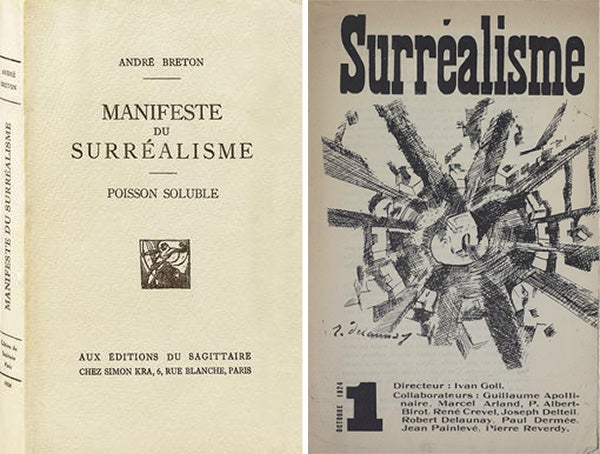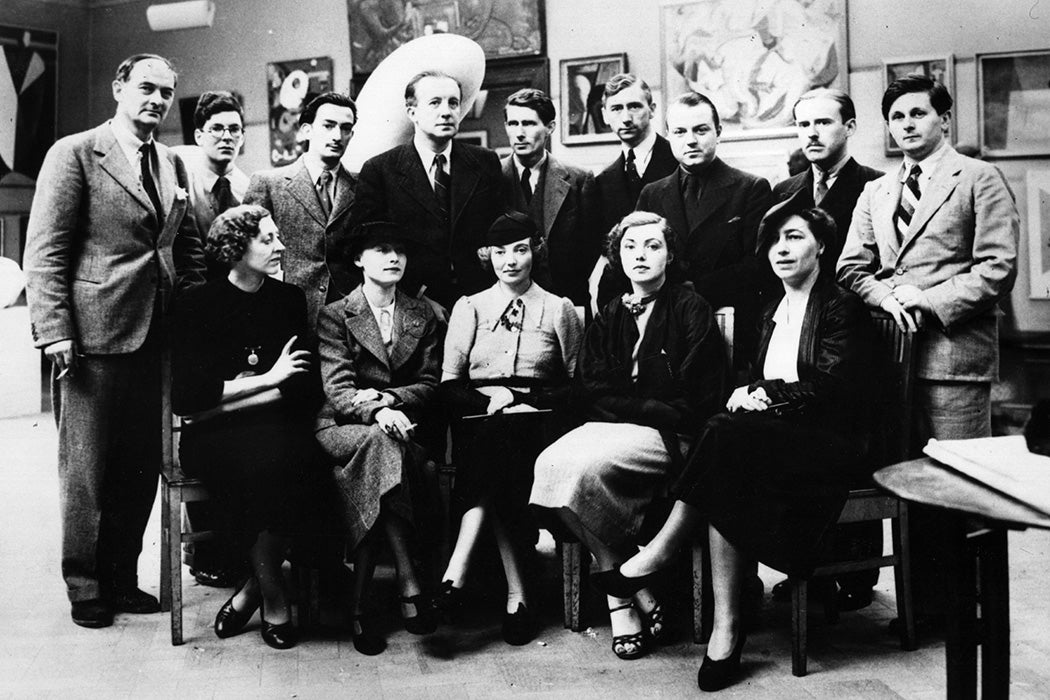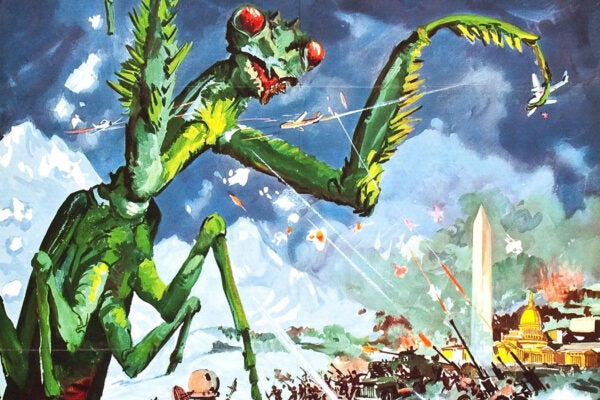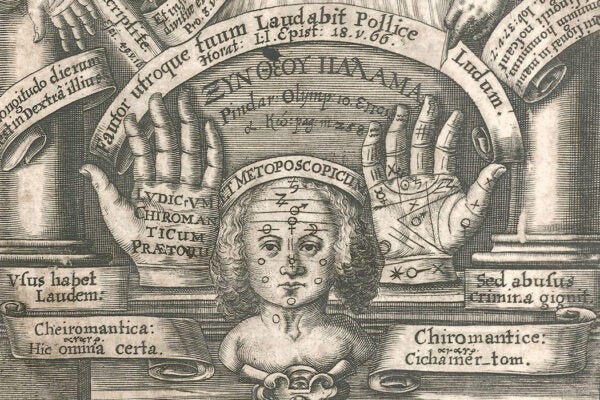On October 15, 1924, French poet André Breton published his Manifeste du surréalisme, arguing for a new form of literary creation that would unlock the subconscious. He defined Surrealism as “pure psychic automatism, by which it is intended to express…the real process of thought. It is the dictation of thought, free from any control by reason and of any aesthetic or moral preoccupation.”
Breton’s publication was actually a bit belated. Two weeks earlier, French-German poet Yvan Goll had published Surréalisme, his version of a manifesto for the movement. Both were men inspired by the visionary writing of French poet Guillaume Apollinaire, who had died in the 1918 flu pandemic two years after he was injured in World War I. Those crises and the wake of uncertainty they had left in Europe would inspire Surrealists, like the Dadaists who had come before them, to embrace the irrational and absurd in the face of a society where reason seemed to have lost its supremacy.

Although the genesis of Breton’s interpretation of Surrealism was in the Paris literary scene, its global legacy would be most visible in art. This included unexpected mashups of objects such as Salvador Dalí‘s 1938 Lobster Telephone that covered the receiver with a crustacean and Meret Oppenheim’s 1936 Object that wrapped a teacup with fur, as well as the dreamlike paintings of Leonora Carrington, René Magritte, and Remedios Varo. It also extended to film, such as the unnerving eyeball slicing of the 1929 Un chien andalou by Luis Buñuel, and photography, such as Man Ray’s transformation of a woman into a musical instrument in the 1924 Le Violon d’Ingres.
On the occasion of the centennial of Surrealism, this reading list examines the movement’s radical beginnings, its surprising popularity as mass entertainment, and its continued relevance in informing contemporary movements like Afrosurrealism.
Willard Bohn, “From Surrealism to Surrealism: Apollinaire and Breton,” The Journal of Aesthetics and Art Criticism 36, No. 2 (Winter 1977): 197–210.
The poet Guillaume Apollinaire is credited with coining the term “Surrealism” in 1917—years before the movement would be considered officially underway—in a preface to a play, using it to describe work that favored surprise and interiority. Art historian Willard Bohn discusses the differences between this definition of Surrealism and the one that followed, while noting the influence of Apollinaire on Breton and others in the Surrealist movement.
“Though their artistic efforts tended in opposite directions, they shared one common meeting ground,” Bohn writes. “At the heart of the two surrealisms lies a fascination with the imagination and its capabilities.”
Charles W. Millard, “Dada, Surrealism, and the Academy of the Avant-Garde,” The Hudson Review 22, No. 1 (Spring 1969): 111–117.
Dada and Surrealism are frequently lumped together, as they were both avant-garde movements pivotal in shaping twentieth-century modernism in Europe. Even as the ideas of some artists, writers, and thinkers overlapped, the movements developed distinct perspectives. Dada began in 1916, embracing absurdity to respond to the upheaval and perceived pointlessness of the violence of World War I.
“Surrealism intellectualized Dada by using Freudian rather than artistic or mechanical references, and the search for the subconscious meaning led to attempts at calling up specific emotions, as in Magritte’s Pleasure, and eventually to the exploration of dream imagery,” writes art historian Charles W. Millard.
Millard highlights that Surrealism didn’t just build on Dada but also responded to and incorporated other styles and movements that came before. Renaissance painting techniques like one-point perspective and chiaroscuro light and dark contrasts, notably things that had been dismissed as passé by many nineteenth-century artists, were reconsidered by the Surrealists.
Jack J. Spector, “André Breton and the Politics of Dream: Surrealism in Paris, ca. 1918–1924,” American Imago 46, No. 4 (Winter 1989): 287–317.
“The Surrealists were of course not the first to put the dream to literary use; but they were the first avant-garde group to make the dream central to their artistic and political goals, and important in their everyday exchanges,” writes art historian Jack J. Spector in this chronicle of the ways Surrealists such Breton elevated the dream from the depths of the subconscious to art. His analysis includes Breton’s published dreams—just some of those recorded by Surrealists as evidence for how sleep could be a space of creation—and a consideration of how Surrealist attempts at collective dreaming led to an interest in political collective action.
Laurent Jenny, “From Breton to Dali: The Adventures of Automatism,” October 51 (Winter 1989): 105–114.
Automatism—a method of creation where automatic rather than planned action guides writing, drawing, or other media—was prominent in the early years of Surrealism, fueled by the automatic writing of the movement’s leader, Breton. Yet as Surrealism expanded beyond Paris, these approaches changed. French critic Laurent Jenny, in a piece translated by Thomas Trezise, contrasts Breton and Spanish artist Salvador Dalí, who, beginning in 1930, challenged some of the ideas of automatism. Jenny writes of this view, quoting from Dalí’s article in the journal Minoataure, in which the artist argued that “[d]reams, like all states of passivity and automatism, deserve to be saved, sublated, provided they are turned to account ‘on the very level of action,’ made to intervene ‘interpretively in reality, in life.’” Dalí’s embrace instead of a “paranoiac-critical method,” in which a paranoid state was entered and interpreted symbolically, as well as the increasing commercialization of his work, would further distance him from Breton.
Georges Hugnet, “In the Light of Surrealism,” The Bulletin of the Museum of Modern Art 4, No. 2/3, Dada and Surrealism: Essays by Georges Hugnet (November-December 1936): 19–32.
Just over a decade after Breton published the Manifesto of Surrealism, the Museum of Modern Art (MoMA) in New York organized Fantastic Art, Dada, Surrealism. The 1936–37 exhibition included art by Surrealists including Salvador Dalí, Max Ernst, René Magritte, and Meret Oppenheim. French artist Georges Hugnet’s essay on the still-evolving practice of Surrealist painting was published alongside the show and translated by Margaret Scolari. Throughout, he notes the blurred lines between Surrealist visual and literary expression, writing that “Surrealism is a mental attitude and a method of investigation; its action runs parallel in every field; time has proved valid the behaviour that it has established for itself.”
Henri Peyre, “The Significance of Surrealism,” Yale French Studies 2, Modern Poets: Surrealists, Baudelaire, Perse, Laforgue (1948): 34–49.
“Through an apparently spontaneous flow of images, Surrealism thaws the crust of blunted perceptions and of deductive reasoning which separates us from our deepest life and from the remnants of childhood buried in our subconscious,” wrote French scholar Henri Peyre in this 1948 essay that argues for the movement’s continued importance even after its early twentieth-century peak. Some of the language in the piece is now dated, particularly that used to reference the African and Polynesian art that inspired many Surrealists. Still, it’s illuminating to read how Surrealism was being evaluated for its cultural influence in the aftermath of World War II, with Peyre touching on everything from its pioneering of non-literary literature to how its poets expressed love.
Irene E. Hofmann, “Documents of Dada and Surrealism: Dada and Surrealist Journals in the Mary Reynolds Collection,” Art Institute of Chicago Museum Studies 22, No. 2, Mary Reynolds and the Spirit of Surrealism (1996): 130–149+197.
Following the initial manifestos, publishing continued to be important for the development of Surrealism. This overview of journals related to Surrealism and Dada demonstrates how they served as platforms for spreading ideas and offering an essential place for collaboration. Irene E. Hofmann, writing about the collection of these journals at the Art Institute of Chicago, observed, “Publications introduced the group’s poetry and imagery and provided a forum for interpretations of dreams and experiments with automatic writing and imagery, and offered a medium for exploring relationships between text and image.” For instance, La Révolution surréaliste in 1927 was the first to publish examples of the popular “exquisite corpse” drawing game, while, after many artists fled Europe for New York at the outbreak of World War II, magazines such as View and VVV were vital for exiled writers and artists.
Katharine Conley, “Surrealism and Outsider Art: From the ‘Automatic Message’ to André Breton’s Collection,” Yale French Studies 109, Surrealism and Its Others (2006): 129–143.
Intuition and automatism were central to Surrealist creation, and its adherents were drawn to work by visionaries, people with mental illnesses, and mediums who claimed to channel messages from the dead. Art historian Katharine Conley investigates the relationship between Surrealism and what’s now known as “outsider art.” Similar to French artist Jean Dubuffet, who saw a purity of expression in art created at the margins, André Breton valued this work as being untarnished by expectations of “high” culture. Conley observes that the approach to outsider and Surrealist art was also often similar.
“Surrealist objects, assembled like collages and glued together in shapes and boxes, or found and renamed, had a psychoanalytic rather than an aesthetic function. Anyone could make them just like anyone could hear the ‘subliminal message’ of surrealist automatism,” Conley writes.
Martine Antle, “Dada and Surrealism Faced with Colonialism,” South Central Review 32, No. 1, Special Issue: Dada, Surrealism, and Colonialism (Spring 2015): 116–119.
Along with drawing attention to outsider art, the Surrealists were interested in the art and artifacts of Latin America, Oceania, and the Pacific Northwest Coast. The visual culture of these places had largely been overlooked as fine art by Europeans. Yet the interest of the Surrealists was rarely informed by actual engagement with people living in these places.
“For despite their faith in their ideology of liberation and their immense and openhearted fascination with other cultures, the surrealists often saw those cultures as exotic objects rather than collectives of real human beings with whom they might productively enter into true dialogue,” writes scholar Martine Antle.
However, some Surrealists, particularly Leonora Carrington and Remedios Varo in Mexico, did spend time immersing in and understanding local culture in a way that didn’t merely appropriate it. Antle’s article is part of a South Central Review issue on Dada, Surrealism, and colonialism, with other pieces covering topics such as André Breton and Vodou in Haiti and ethnographic Surrealism in the 1940s.
Pierre Taminiaux, “Breton and Trotsky: The Revolutionary Memory of Surrealism,” Yale French Studies 109, Surrealism and Its Others (2006): 52–66.
The political side of Surrealist artists and writers is often overlooked, even in considerations of their response to what they perceived as a dissolution of reason and logic in post-World War I Europe. Scholar Pierre Taminiaux explores the connections between the Surrealists and communism, especially following the economic crash of 1929 and the Russian Revolution. For instance, André Breton had a personal relationship with Leon Trotsky, with whom he published a collaborative text about how art and literature could support the struggle for freedom by the people. Although there were some Surrealists who created political art, Taminiaux concludes that it was never what propelled the movement.
“The aesthetics of surrealism definitely outlasted its politics,” he writes. “If the movement survived well after World War II, it was precisely because of its status as an avant-garde movement and not because of its revolutionary rhetoric.”
Chinghsin Wu, “Reality Within and Without: Surrealism in Japan and China in the Early 1930s,” Review of Japanese Culture and Society 26, Commensurable Distinctions: Intercultural Negotiations of Modern and Contemporary Japanese Visual Culture (December 2014): 189–208.
Although much scholarly attention has been focused on Europe, Surrealism had an international footprint. Art historian Chinghsin Wu examines the ways Japanese and Chinese artists engaged with Surrealism in the early 1930s, as “[s]eeing European surrealist painters’ works and learning the main methodologies of surrealism inspired many young artists who were looking for innovative modes of expression to distinguish themselves from conventional art practice.” Wu highlights several influential creators who were inspired by European Surrealism but took its ideas in fresh new directions, such as Koga Harue, who replicated depictions of scientific innovations in his paintings, and Zhao Shou, who involved Eastern philosophy in his approach to the avant-garde.
Sheryl Conkelton, “American Surrealist Photography,” MoMA 16 (Winter–Spring 1994): 20–22.
Surrealism made a major impact in the United States, where it particularly informed photography from the 1930s to the mid-1950s. In this article, timed to run alongside the 1994 American Surrealist Photography exhibition at MoMA in New York, art historian Sheryl Conkelton notes that this influence is most evident in “the appropriation of Surrealist motifs and techniques that made familiar subjects seem strange and expressed a spirit of the ineffable.” This rising interest in distortions of reality in photography and fixations on the uncanny was further given a platform through Surrealist publications like View and VVV. Artists such as Man Ray, Clarence John Laughlin, and Maya Deren often used the advancing technical possibilities of the camera to further play with chance and attempt to capture the unconscious in their images.
Keith L. Eggener, “‘An Amusing Lack of Logic’: Surrealism and Popular Entertainment,” American Art 7, No. 4 (Autumn 1993): 30–45.
Although Surrealism was born in the wake of World War I as something revolutionary, with manifestos and a politically radical motivation in advocating for freedom from reason, it arrived in American popular culture mainly as an aesthetic, with Dalí rather than Breton at the forefront in the mid-1930s.
“When Americans at this time spoke of Surrealism’s attachment to Marx, they were usually talking about Groucho or Harpo,” writes art historian Keith L. Eggener. (He notes, for instance, that in the 1936–37 MoMA exhibition, Walt Disney was included alongside the European artists, something that possibly would not have happened if their Communist leanings were more evident.)
Hannah Crawforth, “Surrealism and the Fashion Magazine,” American Periodicals, Vol. 14, No. 2 (2004): 212–246.
Part of the mainstream presence of Surrealism was fashion. Readers of Harper’s Bazaar could flip to a multiple exposure image by Man Ray of a dramatically asymmetrical gown by Elsa Schiaparelli, while patrons of Vogue could puzzle over a cover illustrated by Salvador Dalí.
“Far from what has thus far been frequently mis-read as a one-way traffic of surrealist ideas and creativity into the fashion magazines, I would suggest that surrealism as a movement was quick to appropriate many of the tropes of the style press, and to make full use of the commercialism inherent to the genre in its own project,” writes scholar Hannah Crawforth in this article on Surrealism’s manifestation in major fashion magazines.
Haim Finkelstein, “The Incarnation of Desire: Dalí and the Surrealist Object,” RES: Anthropology and Aesthetics 23 (Spring 1993): 114–137.
The sculptural “Surrealist object,” where found materials embodied dreamlike, often subversive ideas, was part of the movement from its beginning when Breton presented the concept of “dream objects.” Much like the Surrealist popularity in entertainment and fashion, these objects experienced a curious mainstream interest.
Weekly Newsletter
“However provocative, impertinent, and aggressively ‘anti-artistic’ these objects may have been in the 1930s, especially in the latter half of the decade, they became quite fashionable and were wholeheartedly embraced by the same bourgeois consumers whom they were supposed to befuddle and enrage,” writes art historian Haim Finkelstein in this examination of this history through the work of Dalí.
Terri Francis, “Introduction: The No-Theory Chant of Afrosurrealism,” Black Camera 5, No. 1 (Fall 2013): 95–111.
Surrealism’s legacy in literature and art has continued into the twenty-first century, such as through Afrosurrealism, which responds to the experience of living in a racist society through absurdity and fantastic imagery. With this perspective, it is distinct from much of the Surrealism of the twentieth century, during which Black art was mostly only appropriated without inviting the participation of its creators.
“Part of the work that Afrosurrealism does, alongside Afromodernism, is then to re-center blackness at the core of surrealism and modernism, not as catalytic matter but as the manifestations of black artists’ own modalities,” writes historian Terri Francis. Francis’s piece leads a series of articles further examining Afrosurrealism including through the work of artist Kara Walker and filmmaker William Greaves.
Support JSTOR Daily! Join our membership program on Patreon today.







